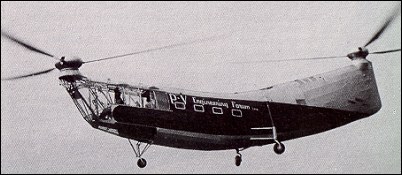
| Piasecki PV-3 / HRP "Rescuer" 1943 |  |
 |

| Piasecki PV-3 / HRP "Rescuer" 1943 |  |
 |
|
Although it was built only in modest numbers and had an unspectacular (though useful) service career, the Piasecki HRP-1 has its place in the history of rotorcraft by virtue of being the world's first practical tandem-rotor helicopter and, at the time of its appearance, the world's largest helicopter of any kind. Frank N. Piasecki, holder of the first helicopter pilot's licence to be issued in the United States, became interested in rotorcraft development before America's entry into World War 2, and in 1943 he formed a company known as the P.V. Engineering Forum whose first design, the PV-2, was a single-seat, single main rotor helicopter with a 90hp Franklin engine. This machine, which flew for the first time on 11 April 1943, was Piasecki's first and only single-rotor helicopter, for on 1 February 1944 he received a contract to develop a tandem-rotor utility transport and rescue aircraft for the U.S. Navy. Given the factory designation PV-3, this machine, powered by a Wright R-975 piston-engine, made a successful first flight at Morton, Pennsylvania, in March 1945 and was followed by two XHRP-1 prototypes, one for U.S. Navy flight trials and the other for static and dynamic tests. The test programme was completed in the spring of 1947, by which time the company title had changed to Piasecki Helicopter Corporation, and work had already begun on an initial batch of ten HRP-1 Rescuers ordered by the U.S. Navy in June 1946. The first of these flew on 15 August 1947, and a second batch of ten was built later, the final machine being delivered in 1949. These were powered by 600hp Pratt & Whitney R-1340-AN-1 engines. Twelve of the HRP-1's were eventually assigned to the U.S. Marine Corps for assault training, while three others, as HRP-1G's, were used as rescue craft by the U.S. Coast Guard. After withdrawal of the Rescuer from military service in the early 1950s, about six appeared on the U.S. civil register. The tandem-rotor layout offered a wider choice of e.g. positions, together with a small frontal area and a large lifting area; thus the HRP-1 was able to register a significant step forward, from craft whose main purpose had been to prove the flight principles of the helicopter, to a vehicle capable of : doing a real job of work. Nicknamed - for obvious reasons - the 'flying banana', the HRP-1 carried a crew of 2 sitting in tandem, and its 11.33m3 cabin could accommodate 8 passengers, 907kg of cargo or 6 stretchers. The single engine was mounted in the rear part of the fuselage, with a clutch and gearbox amidships from which drive shafts ran to reduction gearboxes below each of the rotor hubs. In June 1948 the U.S. Navy ordered five examples of the much-developed PV-17 with the designation HRP-2. This had a considerably longer, redesigned fuselage with an all-metal skin (the HRP-1's front half was fabric-covered), a more roomy crew cabin with side-by-side seats, and modified rotor heads. This version formed the basis of the later PD-22 model which became the highly successful military Vertol H-21 series. K.Munson "Helicopters And Other Rotorcraft Since 1907", 1968
The first tandem rotor helicopters built by Frank Piasecki were nicknamed "flying bananas". The prototype, the PV-3, which was designated HRP-1 by the US Navy, flew 13 months after the go-ahead was received for the project. At the time this was the world's largest helicopter. Tests were completed at the beginning of 1947 when P.V. Engineering Forum, founded by Piasecki in 1943, restyled itself the Piasecki Helicopter Corporation. The first model from the initial batch of ten, which had a 600hp Pratt & Whitney engine mounted at the rear of the fuselage, flew that summer. The tandem rotor configuration chosen by Piasecki allowed fairly generous center of gravity margins (important when carrying bulk loads). In addition to those used for transport and search and rescue operations by the Navy, 12 HRP-1s were assigned to the US Marines for landing exercises. G.Apostolo "The Illustrated Encyclopedia of Helicopters", 1984
Frank N. Piasecki was the holder of the first US helicopter pilot's licence and he formed the P V Engineering Forum in 1943 to develop practical rotorcraft. His first successdul design was the experimental Piasecki PV-2 single-seater with a 67kW Franklin flat-four engine driving a three-blade main rotor. Piasecki himself was the pilot for the first flight, made on 11 April 1943. The next design was the PV-3, a development aircraft for the US Navy's HRP Rescuer transport and rescue helicopter. Ordered by the US Navy on 1 February 1944 and powered by a Wright R-975 piston engine, the tandem-rotor PV-3 first flew at Morton, Pennsylvania in March 1945. It was followed by two XHRP-1 airframes, one of which was used for static tests while the other undertook the flight development programme, during the course of which the company changed its name to Piasecki Helicopter Corporation, in June 1946 receiving an initial order for 10 production HRP-1 helicopters. The first flew on 15 August 1947, powered by a 447kW Pratt & Whitney R-1340-AN-1 engine; 20 were built eventually, with a metal-skinned rear fuselage and fabric covering over the main cabin section, although they were often flown with the fabric removed. Service evaluation was undertaken by US Navy Squadron VX-3 and US Marine Corps Squadron HMX-1, while three were delivered to the US Coast Guard with the designation HRP-1G. Five improved PV-17 helicopters, with all-metal fuselage skinning, were ordered in June 1948 as the HRP-2, and these also served with the US Coast Guard. D.Donald "The Complete Encyclopedia of World Aircraft", 1997 
|